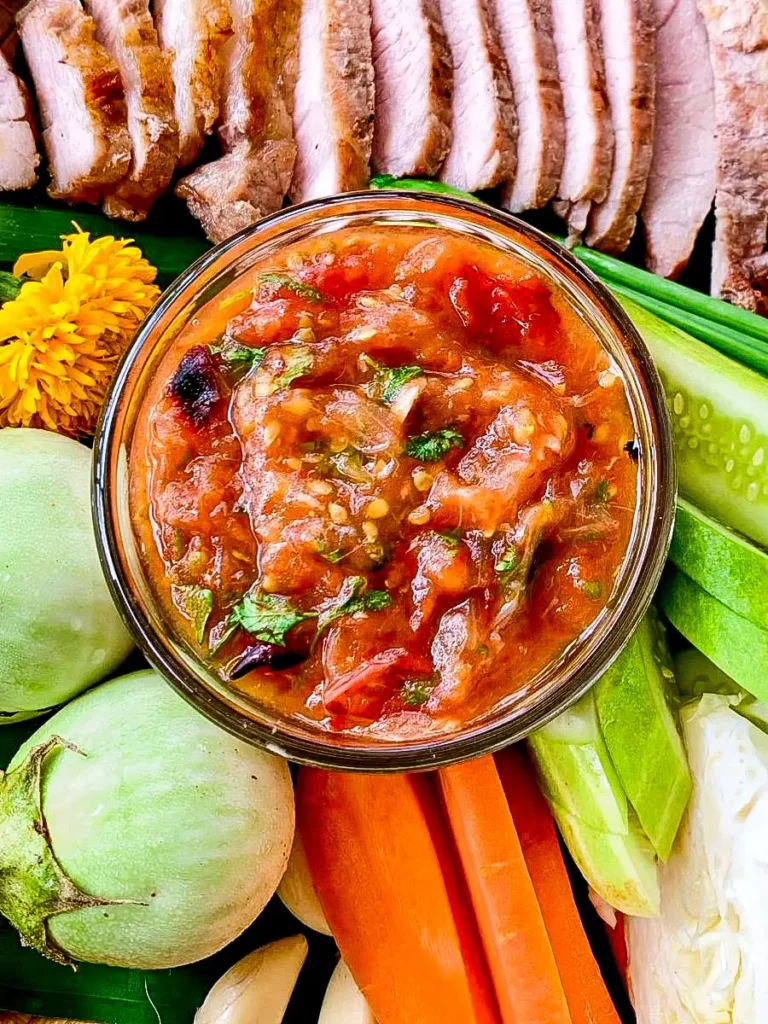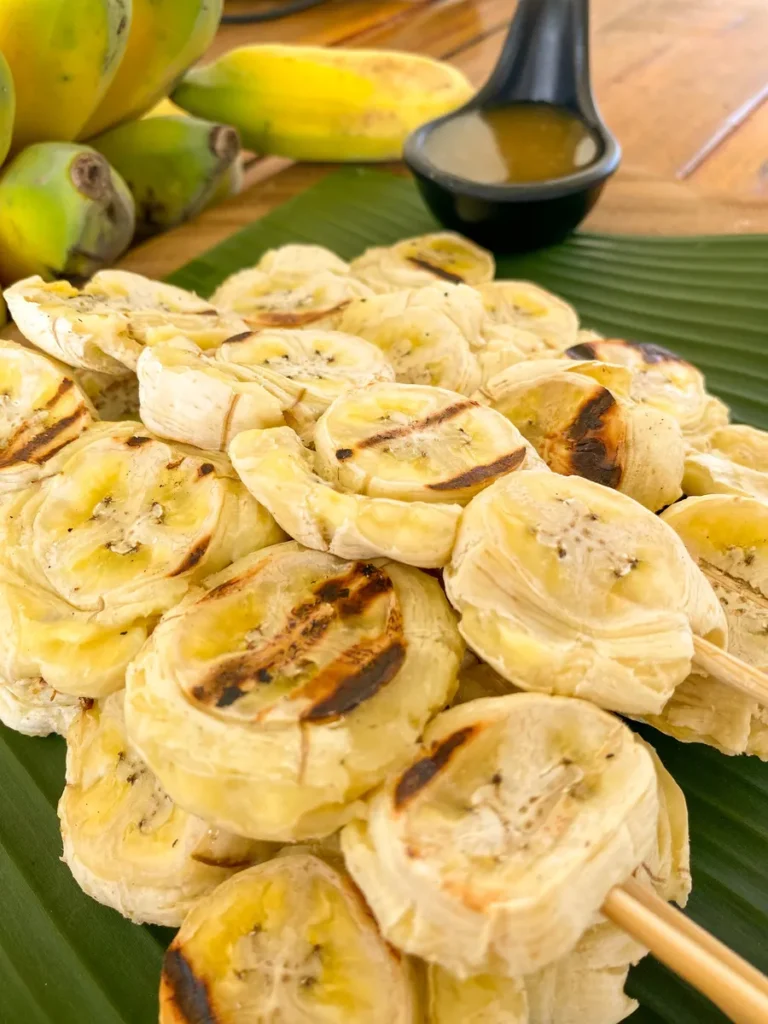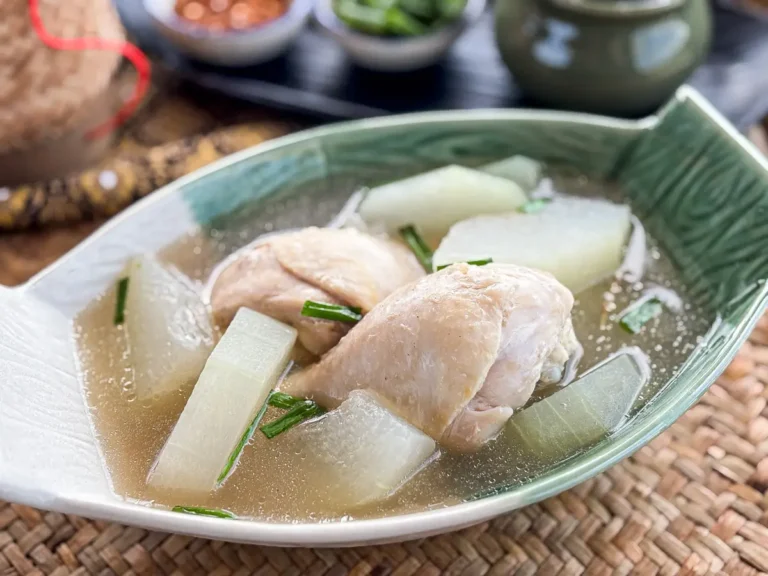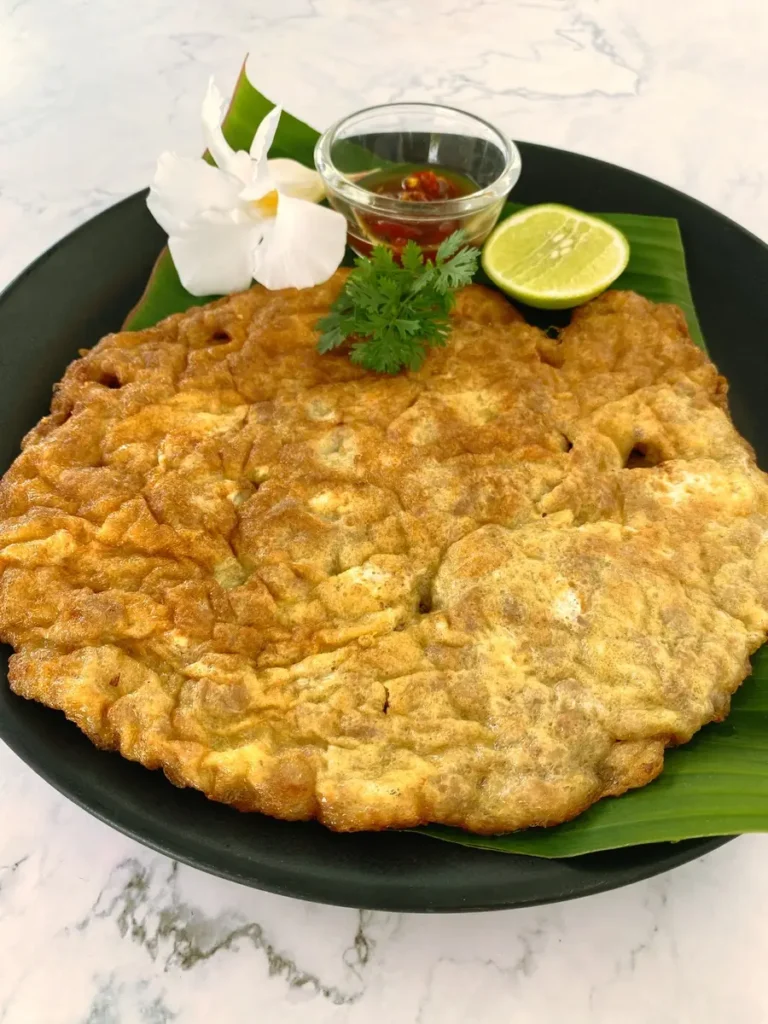Jeow Mak Len (Lao Tomato Dipping Sauce Recipe)
As an Amazon Associate, I earn from qualifying purchases. Read the full disclosure here .
Jeow mak len is hands down THE BEST Lao tomato dipping sauce recipe that goes with EVERYTHING. It’s easy, it’s versatile, it’s a smoky and spicy condiment perfect for summer and year round.

What is jeow mak len
Jeow mak len is a traditional Laotian tomato dipping sauce. It’s a spicy accompaniment for sticky rice, grilled fish, grilled chicken, and fresh vegetables. The sauce is made by charring tomatoes, garlic, shallots, and chilies, which are then combined with fish sauce and cilantro.
Thai and Lao dipping sauces
Thai and Lao dipping sauces are my kind of yum. They’re often spicy, sweet, tangy, and make use of regional ingredients like fish sauce, chilies, and fresh herbs.
Fans of Isan and Lao cuisines know that both are quite similar. Both kitchens share a love for zesty, spicy salads like green papaya salad – som tum Thai – and larb salads like this larb ped recipe.

Another love of both are spicy dipping sauces.
Thailand’s charred dipping sauce nam prik noom and this Laos jeow mak len are a perfect example.
Similarly, nam jim jaew in Thai cuisine has its Lao counterpart – jeow som.
Lao tomato dipping sauce
This recipe for jeow mak len is like a spicy salsa-like dip with a serious spicy kick and smoky flavor.
With a base of tomatoes and simple ingredients, this sauce can be served at any party. It pairs with just about anything, from sticky rice to steamed fish and even fresh vegetables.
And if you’ve got some little ones running around, you can easily tone this down for the kiddos. It’s family-friendly and super tasty!
Mortar and pestle or food processor

The secret to the best Lao dipping sauce with tomatoes is charring the tomatoes, garlic, shallots, and chilies. Then mash it into a sauce with a mortar and pestle, extracting their natural juices and flavor.
Then, we’ll brighten up our roasted tomato dipping sauce with fish sauce and cilantro.
If you’re short on time, you can make your sauce with a food processor on the pulse setting, too. In this case, you can just mix all the ingredients into a savory paste, no need for a particular order.
Travel through Laos, and you’ll discover different flavors and ingredients for jeow mak len – just like you would in Thailand in Thai restaurants. Some versions might include onions, green onions, ginger, MSG, or even fermented fish sauce.
Looking for more traditional spicy dipping sauces?
Ingredients
Ingredients can be sourced at Asian grocery stores and Asian markets.
The exact measurements are in the recipe card at the end of this post.

- Tomatoes – Tomatoes are the base of this “salsa dip”, adding a fresh, juicy base. You can use cherry tomatoes, Roma tomatoes, or whatever small tomatoes you’ve got.
- Fish sauce – Made with fermented fish, fish sauce adds umami and a salty flavor. It’s a key ingredient in both Thai and Lao cuisines, so don’t skip it. You can get a high quality fish sauce like red boat fish sauce at Amazon. If you’re vegetarian, you can use a vegetarian fish sauce alternative.
- Shallots – I suggest using shallots instead of onions or red onions. They add an extra depth of flavor with a natural, mild sweetness.
- Chilies – Use Thai chilies like bird’s eye chilies or Jinda chili peppers. If you can’t handle heat, you can use a milder type like jalapeños.
- Garlic – Charred garlic adds a smoky, aromatic depth. If you love garlic, feel free to up the amount.
- Coriander (cilantro) – Adds a fresh, citrusy taste. They serve as garnishing as well. You can also use green onions if you have that.
- White sugar (optional) – Charring the shallots unlocks their natural sweetness, so there’s no need for extra sugar. Healthy? Check! However, if your tomatoes are too tart or acidic, you can add a touch of sugar to balance the flavors. If you want to use sugar, you can start with 1/2 tablespoon of white sugar, brown sugar, or palm sugar.
Cooking instructions
Living in rural Thailand, I used a traditional charcoal grill for charring. Many Thai households don’t have an oven.
You can use a grilling pan over low heat, or an oven / air fryer if a charcoal grill is not an option, but you’ll miss out on that traditional smoky flavor.
Char tomatoes, chilies, shallots, and garlic

Place the tomatoes, shallots, garlic, and fresh chili peppers over charcoal to char them. The garlic and shallots should be unpeeled. Occasionally turn them to ensure even charring. Make sure the ingredients don’t burn. You can put them on a skewer to make flipping easier.
After charring, allow the shallots and garlic to cool before peeling.
Pound the tomato dipping sauce
1. Crush the chilies, garlic, and shallots using a mortar and pestle.
2. Add the tomatoes, fish sauce, and coriander. Continue to pound and mix until the mixture achieves a dipping sauce consistency.
Tips for the best Lao spicy sauce
- Put the vegetables on bamboo skewers. This makes it easier to flip and prevent burning of the ingredients. Soak the skewers in water for 10 minutes first. With my open charcoal grill, it’s pretty easy to flip them without skewers, you can use tongs if you’re comfortable grilling over charcoal / a BBQ grill.
- Use this dipping sauce for meal prep. You can totally make this sauce ahead of time, it will make the flavors even better.
- Use a mortar and pestle. To get the maximum flavor, use a mortar and pestle. This brings out the natural juices and adds to the authenticity. You can use a food processor on the pulse setting as an alternative.
- Customize the heat. Go easy on the chilies if you’re not a fan of spicy food. Alternatively, you can remove the seeds.
- Char, don’t burn. The peppers will roast fast, so keep an eye out.
- Test the acidity. If your sauce is too acidic, add a little sugar to balance it.
Kitchen tools
- Mortar and pestle or food processor
- Bamboo skewers
What do you eat with jeow
- Meat and fish: You can have it with grilled fish, steamed fish, fried fish, mookata (Thai BBQ), Thai chickµen wings, sausages, and beef jerky or moo dad deaw. You can also pair it with pork rinds.
- Fresh veggies: Use it as a dip for raw vegetables like yard long beans, cabbage, sliced cucumber, and Thai eggplants.
- Lettuce wrap: Pair it with lettuce and my pork larb recipe or with grilled chicken. Stuff the lettuce with sauce and protein, the same way you’d eat a taco.
- Thai sticky rice: Jeow dipping sauces and sticky rice are a must. In both Isan and Laos, sticky rice is a staple known as “khao niew”. Roll the glutinous rice into a ball, dipping it into the spicy dip.
- Others: Spread it on toasted bread, a sandwich, use it as a dip for nachos or other chips.
How to store
Transfer the sauce into an airtight container and pop it in the refrigerator. It will stay fresh for a few days up to a week, perfect for meal prep. Stir before serving, optionally squeezing in some fresh lime juice.
Remember to use fresh ingredients to extend the storage time.
Did you know?
- The word “jaew” or “jeow” in Lao cuisine refers to any kind of dipping sauce. The words “mak len” means tomato, translating to tomato sauce. Jaew is a staple in many Lao meals.
- Lao jeow dipping sauces are always spicy, made with lots of chilies.
- Lao and Isan culture share the tradition of communal eating, and we prefer food with intense flavor.
- This sauce goes by many names: jaew mak len, jiew mak len, nam jaew mak, and more.
- There are many more popular jeow sauces like jeow som, jeow bong, and jeow mak keua.
Frequently asked questions
How spicy is this dipping sauce?
This dipping sauce is medium spicy. The heat level varies based on the number of chilies you add, and the type of chilies you use. Feel free to adjust.
Is jeow mak len gluten-free?
Yes, jeow mak len is gluten-free. However, always double-check the labeling of your store-bought fish sauce to ensure they don’t contain any gluten additives.
More spicy dipping sauce recipes you’ll love
- Tamarind dipping sauce
- Thai green chili sauce
- Nam jim seafood
- Nam prik kapi – A chili dip with shrimp paste.
- Prik nam pla
- Jeow het
If you loved reading this jeow mak len recipe, please make my day by dropping a star rating and/or a comment below!
Jeow Mak Len (Lao Tomato Dipping Sauce Recipe)

Ingredients
- 1 cup cherry tomatoes
- 1/2 cup shallots, sliced
- 3 chilies, adjust to taste
- 4 cloves of garlic, peeled
- 1 tablespoon fish sauce
- 1 tbsp cilantro, chopped
- 1/2 tablespoon white sugar, optional, see notes
Instructions
- Place the tomatoes, shallots, garlic, and fresh chili peppers over charcoal to char them. The garlic and shallots should be unpeeled. Occasionally turn them to ensure even charring. Make sure the ingredients don’t burn. You can put them on a skewer to make flipping easier.
- After charring, allow the shallots and garlic to cool before peeling.
- Crush the chilies, garlic, and shallots using a mortar and pestle.
- Add the tomatoes, fish sauce, and coriander. Continue to pound and mix until the mixture achieves a dipping sauce consistency.
Notes
- Use the nutrition card in this recipe as a guideline.
- Put the vegetables on bamboo skewers to have an easy time charring them.
- Add chilies to taste.
- Charring the shallots unlocks their natural sweetness, so there's no need for sugar in my opinion. However, if your tomatoes are too tart or acidic, you can add a touch of sugar to balance the flavors. If you want to use sugar, you can start with 1/2 tablespoon of white sugar, brown sugar, or palm sugar.






